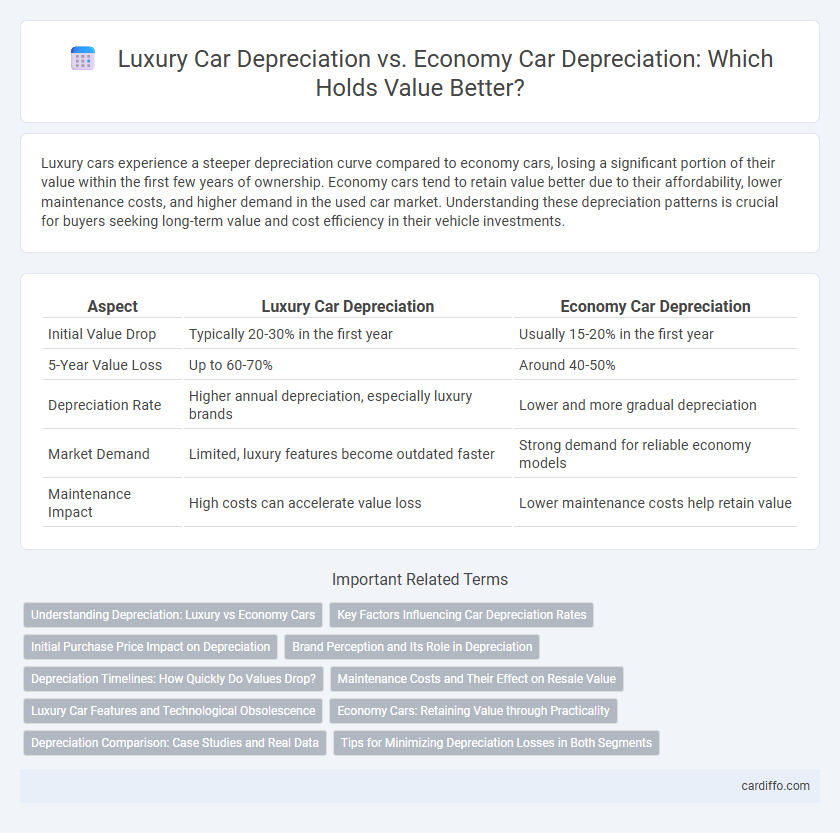Luxury cars experience a steeper depreciation curve compared to economy cars, losing a significant portion of their value within the first few years of ownership. Economy cars tend to retain value better due to their affordability, lower maintenance costs, and higher demand in the used car market. Understanding these depreciation patterns is crucial for buyers seeking long-term value and cost efficiency in their vehicle investments.
Table of Comparison
| Aspect | Luxury Car Depreciation | Economy Car Depreciation |
|---|---|---|
| Initial Value Drop | Typically 20-30% in the first year | Usually 15-20% in the first year |
| 5-Year Value Loss | Up to 60-70% | Around 40-50% |
| Depreciation Rate | Higher annual depreciation, especially luxury brands | Lower and more gradual depreciation |
| Market Demand | Limited, luxury features become outdated faster | Strong demand for reliable economy models |
| Maintenance Impact | High costs can accelerate value loss | Lower maintenance costs help retain value |
Understanding Depreciation: Luxury vs Economy Cars
Luxury cars depreciate at a faster rate than economy cars due to higher initial purchase prices and significant loss of value in the first few years. Economy cars experience slower, steadier depreciation, driven by lower market demand fluctuations and more stable resale values. Understanding depreciation differences is crucial for buyers aiming to balance vehicle cost against long-term investment and resale potential.
Key Factors Influencing Car Depreciation Rates
Luxury car depreciation rates tend to be significantly higher than those of economy cars due to factors such as initial purchase price, brand perception, and maintenance costs. High-end vehicles experience rapid value loss driven by technological obsolescence, costly repairs, and market demand shifts. Economy cars benefit from lower depreciation as affordability, fuel efficiency, and reliability maintain steady resale value in a competitive used car market.
Initial Purchase Price Impact on Depreciation
Luxury cars experience a steeper absolute depreciation due to their significantly higher initial purchase prices, often losing tens of thousands of dollars within the first few years. Economy cars, with lower upfront costs, depreciate less in absolute terms but can have comparable percentage losses. The impact of the initial purchase price is critical in determining the total depreciation amount, influencing resale value and long-term ownership costs.
Brand Perception and Its Role in Depreciation
Luxury car depreciation rates are significantly affected by brand perception, as prestigious brands like Mercedes-Benz and BMW tend to retain value better due to their strong reputation for quality and status. Economy cars from brands such as Toyota and Honda experience slower depreciation primarily because of their reliability and low maintenance costs, which appeal to budget-conscious buyers. Brand perception drives resale value, influencing how quickly different vehicle categories lose value over time in the used car market.
Depreciation Timelines: How Quickly Do Values Drop?
Luxury cars typically experience rapid depreciation within the first three years, losing up to 60% of their initial value due to high purchase prices and costly maintenance. Economy cars generally retain value better, with depreciation rates around 40% over the same period, driven by stronger demand and lower upfront costs. Understanding these timelines helps buyers anticipate long-term resale values and overall cost of ownership.
Maintenance Costs and Their Effect on Resale Value
Luxury cars experience higher maintenance costs, accelerating depreciation and significantly lowering resale value compared to economy cars. Economy vehicles incur lower repair and upkeep expenses, preserving their value longer and making them more affordable in the used car market. Maintenance cost disparities directly impact the rate of depreciation, influencing long-term ownership expenses and resale profitability.
Luxury Car Features and Technological Obsolescence
Luxury cars experience accelerated depreciation due to high initial costs combined with rapid technological obsolescence, diminishing their resale value faster than economy cars. Advanced features like cutting-edge infotainment systems and autonomous driving technologies become outdated quickly, undermining the perceived value of luxury vehicles. In contrast, economy cars retain value longer due to simpler, more stable technology and lower initial expenditure.
Economy Cars: Retaining Value through Practicality
Economy cars typically experience slower depreciation rates compared to luxury vehicles due to their practical appeal and lower initial cost, making them more affordable to maintain and insure. Their value retention is supported by consistent demand in the used car market, driven by factors such as fuel efficiency, reliability, and lower repair expenses. Buyers prioritize economy cars for daily commuting and cost-effective ownership, which helps sustain their market value over time.
Depreciation Comparison: Case Studies and Real Data
Luxury cars experience an average depreciation rate of 50-60% within the first five years, significantly higher than economy cars, which typically depreciate around 40-45% during the same period. Case studies, such as those from Kelley Blue Book and Edmunds, reveal that luxury brands like BMW and Mercedes-Benz lose value faster due to higher maintenance costs and market saturation. Real data indicates economy cars from Toyota and Honda retain value better, benefiting from stronger demand in the used car market and lower ownership costs.
Tips for Minimizing Depreciation Losses in Both Segments
Luxury car depreciation typically occurs faster due to higher initial costs and rapid value drops, while economy cars depreciate more steadily but to a lesser extent. Maintaining meticulous service records, avoiding excessive mileage, and protecting the vehicle from damage significantly minimize depreciation losses in both segments. Choosing models with strong resale value and timing the sale before major depreciation milestones further preserve investment returns.
Luxury Car Depreciation vs Economy Car Depreciation Infographic

 cardiffo.com
cardiffo.com